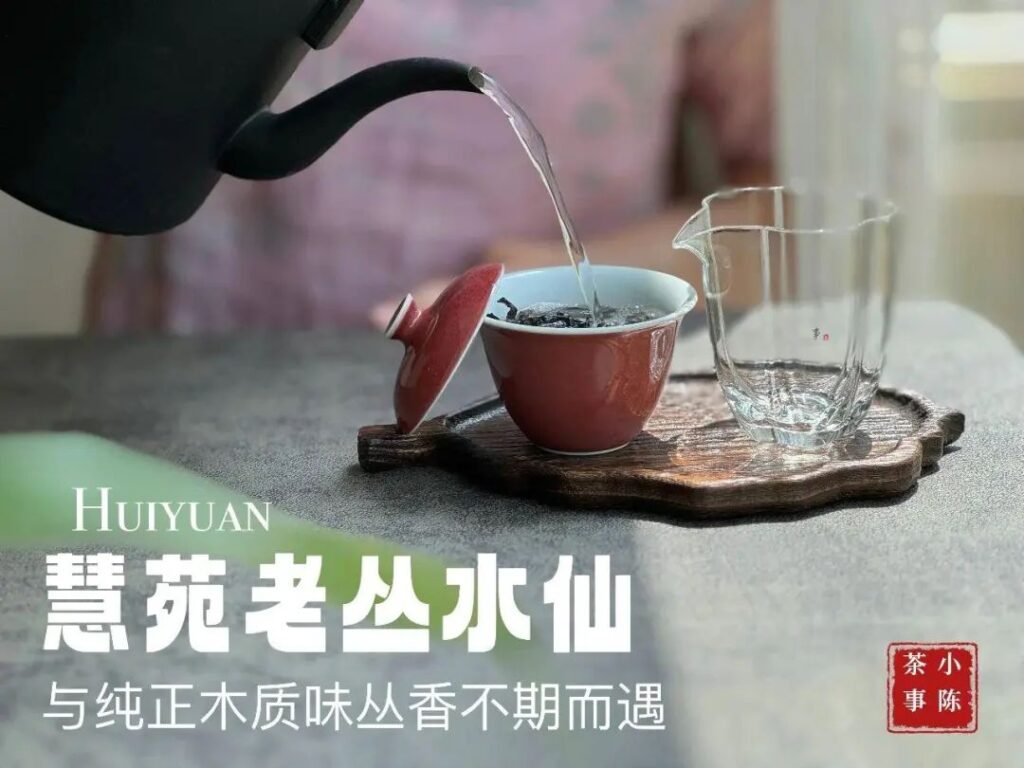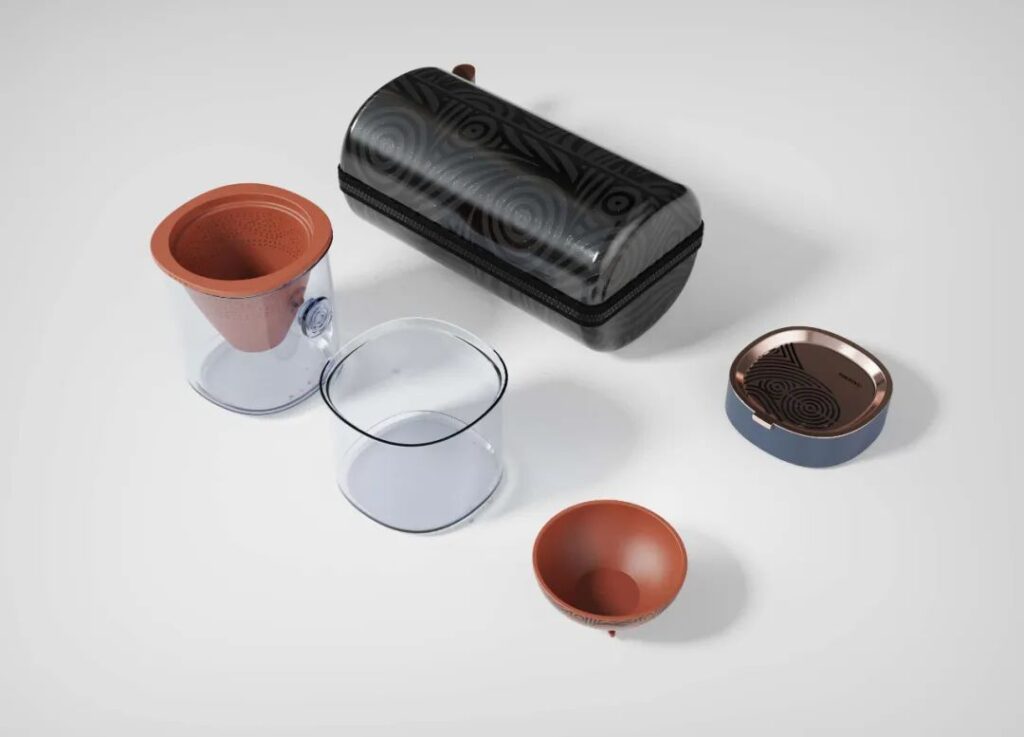The ambiance of drinking tea is one of tranquility. Compared to tea gatherings with many people, the feeling of drinking alone is more comfortable. The method of brewing tea is unrestricted; you can brew it however you like. In your cozy little corner for brewing tea, place a newly purchased potted plant. Hang a painting of flowers and birds on the bookshelf behind. After drawing the gauze curtain, look at the tall green trees outside the window.
The swaying shadows and faint outlines create a serene scene. Turn on the warm indoor desk lamp, and the room is instantly filled with warmth. Take this moment to search and match the perfect cups and saucers. With a few quick steps, you can create a comfortable tea brewing environment. During daily tea drinking, most occasions are spent drinking alone. To enjoy the happiness brought by ‘solo tea’, what tea utensils should beginners add to their collection?I. Minimalist Solo Tea. Brewing tea can be complex or simple. The same goes for the matching of tea utensils. While it’s good to have a complete set according to different styles, seeking simplicity with a minimalist approach is also acceptable. For a minimalist tea corner, there’s no need for many items; just a cup and hot water are enough to brew. Even without a dedicated tea table, you can clear a part of your office desk/writing desk/desk.
If there’s a power source nearby that can support boiling water, that’s great. If you’re drinking tea in a dormitory, office, or during a long-distance high-speed train journey without the ability to boil water on the spot, it’s not a problem. Prepare a slightly larger capacity thermos, fill it with nearly 1L of boiling water, and screw on the cap to keep it warm. In this way, the problem of hot water supply is solved. For a minimalist personal tea drinking method, a glass cup the is best choice. After cleaning the cup, put in a pinch of dry tea, pour in hot water, and wait for a few minutes before drinking. After drinking most of the tea, leaving less than 1/5 of the dregs at the bottom of the cup, and being busy with other tasks, such as answering a work call or solving a problem. When you return, the remaining tea at the bottom of the cup is completely cold, and you can refill it with hot water to neutralize it, and you can still enjoy a good taste. II. Basic Versatile White Porcelain Gaiwan. Whether for multiple people or solo drinking, it’s necessary to have a basic white porcelain gaiwan at home. Pure white glaze, without any patterns. The shape is simple, and the glaze is smooth. Light, convenient, and affordable, the white porcelain gaiwan is not expensive on the market. Very few are priced over three digits, and most tea drinkers can afford it. Moreover, such a basic white porcelain gaiwan is very versatile for brewing tea. It can almost ‘accept all comers’, no matter what kind of tea, it can be brewed in it. Green tea, black tea, white tea, rock tea, pu-erh, single bush, Tieguanyin, etc., with a gaiwan in hand, brewing tea is no longer a worry. The wide-mouthed shape of the gaiwan is highly compatible, even if it encounters thick and fluffy dry tea, there’s no need to worry about not being able to fit it.The tightly glazed surface of the small Gaiwan does not absorb any tea aroma, while also being easy to clean, leaving no sanitation dead corners. A simple wipe and it’s as good as new. During daily use, there’s no need to worry about one pot for one type of tea. Even when drinking alone, the standard capacity of 110 milliliters for the Gaiwan does not seem too large. The brewed tea, poured into a teacup of about 45-50 milliliters, meets the requirement of ‘tea fills to eight parts full’, which is just three small cups.
Holding the cup and sipping slowly, one can enjoy the tea-drinking time, feeling extremely comfortable and happy. III. For night-time high-end tea drinking, a small Gaiwan is essential. Many tea enthusiasts find themselves busy during the day and only have time to sit down and enjoy tea slowly after work. Drinking tea at night often means it’s hard to gather friends for a tea gathering. Most of the time, after dinner, one tidies up the table. The remaining time is spent at home, flipping through a leisurely book or watching a series. Pairing this with tea is simply perfect. There are many considerations for the tea suitable for drinking at night. Generally, one chooses tea with a mild flavor, high theanine content, and not much bitterness. For example, Zhengyan Lao Cong Shui Xian, Zhengyan Zu Huo Rou Gui. Or, high mountain Yin Zhen from the core production area, aged Bai Cha. Or, Tongmu Yan Xiao Zhong, Jin Jun Mei, etc. A tea friend once asked if it would be a waste to drink a 500-plus Niulan Keng Rou Gui by oneself. The response was that as long as one can finish drinking it, from the first to the last infusion, without missing a single hint of tea flavor, it cannot be considered waste. However, when drinking tea alone at night, with few people present, the consumption speed of the brewed tea is slow. After four or five infusions, most people are already satisfied, having quenched their tea thirst and enjoyed themselves. But the core high-quality tea on hand can be brewed at least ten times, with more than half of the tea flavor left unfinished. Leaving half of it and saving the leaves for the next day turns it into overnight tea, which is not suitable for drinking. Forcing oneself to continue brewing and drinking, even without worrying about insomnia from tea, will inevitably increase the number of times one gets up at night before sleep. At this point, the best compromise is to switch to a smaller Gaiwan. Under the premise of unchanged tea-water ratio, a small Gaiwan of 80-90ml saves more tea. Tea enthusiasts who have the habit of drinking late tea for leisure and relaxation may consider buying a small Gaiwan for themselves. It is specially used for drinking high-end tea at night, saving tea and avoiding waste. The same box of tea can yield a higher cost-performance ratio! IV. Even when drinking alone, the fairness cup has its uses. ‘Is it necessary to use a fairness cup when drinking tea alone?’ This is a popular topic of discussion within the circle. In fact, whether to use it or not depends on the individual. According to the characteristic Gongfu tea brewing method of the Chaoshan area, placing three tea cups on the tea tray to form a ‘pin’ shape.When pouring tea from a Gaiwan, the method known as ‘Guan Gong Xun Cheng’ is used to evenly divide the tea soup into three small cups. Any tea that spills during the pouring process is caught by a tea tray underneath, ensuring the tabletop remains dry. Additionally, in some regions, it is customary to drink tea directly from the Gaiwan. After lifting the Gaiwan, one uncovers and blocks the floating tea leaves with the lid, then drinks directly. Nowadays, there is a new approach within the tea community, which combines a small Gaiwan with a large teacup. By using a slightly larger, wide-mouthed cup for drinking, one can pour the entire infusion directly from the Gaiwan into the cup without the need for a fair cup. This eliminates the need for additional tea distribution, allowing for a more refreshing tea-drinking experience. While omitting the fair cup saves a piece of equipment and simplifies the tea-making process, it is important to note that the fair cup serves more than just a decorative purpose. It facilitates the pouring and distribution of tea, and a glass fair cup, in particular, allows for a clear view of the tea’s color. Furthermore, allowing the tea to rest in the fair cup before serving can cause any small debris to settle at the bottom, preventing it from being poured out with the tea. Even when drinking alone, having a fair cup nearby does not feel cumbersome but rather enhances the tea-drinking ritual. Whether in the office or at home, a small tea tray can instantly elevate the tea-drinking experience. By placing a tea tray and arranging the Gaiwan, fair cup, and teacup on it, one can highlight the unique function of the tea table. Without it, a tea table might not seem distinct from an ordinary desk. There are many affordable options for simple tea trays under a hundred dollars, including rattan, bamboo mats, solid wood, hardwood-framed Begonia glass, and scroll-style portable tea mats, among others. With a tea tray as the finishing touch, the entire setup becomes more pleasing to the eye. Drinking tea is not only about pursuing a more comfortable aroma, richer taste, and refreshing aftertaste but also about ‘pleasing oneself’. By setting up an elegant and comfortable tea-making space and adding various convenient and aesthetically pleasing tea utensils, one can both brew good tea and uplift one’s mood. Immersed in this practice, even as time passes, one can find small joys everywhere.


